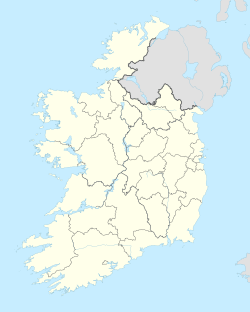Sonnagh fort facts for kids
|
Ráth an tSonnaigh
|
|
| Location | Sonnagh, Aughnacliffe, County Longford, Ireland |
|---|---|
| Coordinates | 53°49′51″N 7°36′02″W / 53.830744°N 7.600570°W |
| Type | ringfort |
| Area | 0.39 ha (0.96 acres) |
| History | |
| Material | earth |
| Periods | Bronze or Iron Age (c. 2400 BC – AD 400) |
| Site notes | |
| Ownership | private |
| Designation | National Monument |
Sonnagh fort is an ancient circular earthwork, also known as a ringfort or rath. It is a special place in County Longford, Ireland, protected as a National Monument. This means it's an important historical site that helps us understand how people lived long ago.
Contents
Where is Sonnagh Fort Located?
Sonnagh fort is found about 1.2 km (0.75 mi) west of Lough Gowna, a beautiful lake. It's also about 7.2 km (4.5 mi) north-northeast of Ballinalee. The fort sits on high ground, giving it a great view over the flat lands stretching towards County Westmeath. This high spot was probably chosen for safety and to see anyone approaching.
What Does Sonnagh Fort Look Like?
Sonnagh fort is a large enclosure with two sets of banks and ditches. This type of fort is called "bivallate," meaning it has two protective walls or mounds. These banks were made of earth and helped keep the people and animals inside safe. Right next to the fort, on its eastern side, there is a natural spring of water. This would have been very useful for the people living there, providing fresh water.
Who Lived at Sonnagh Fort?
Sonnagh fort is one of seven ringforts in the area around Aughnacliffe. It is the best-preserved one. These forts were not usually military bases or castles. Instead, they were more like protected homes or farms for families and their animals. They were built to keep people safe from wild animals or other dangers.
Homes Inside the Fort
The houses inside these forts were mostly made of wood. A common building method was called "post and wattle" construction. This involved weaving thin branches (wattle) between wooden posts. The walls often had two rows of wattle, with a space of about 20 cm (8 inches) in between. This space was filled with materials like straw and bracken to help keep the house warm. The roofs were usually thatched with straw and supported by strong wooden posts.
What Does the Name "Sonnagh" Mean?
The name of the fort, "Sonnagh," actually comes from the Irish word sonnach. This word means "palisade," which is a fence made of strong wooden stakes. This tells us that the fort's protective walls were a very important part of its design and identity.


